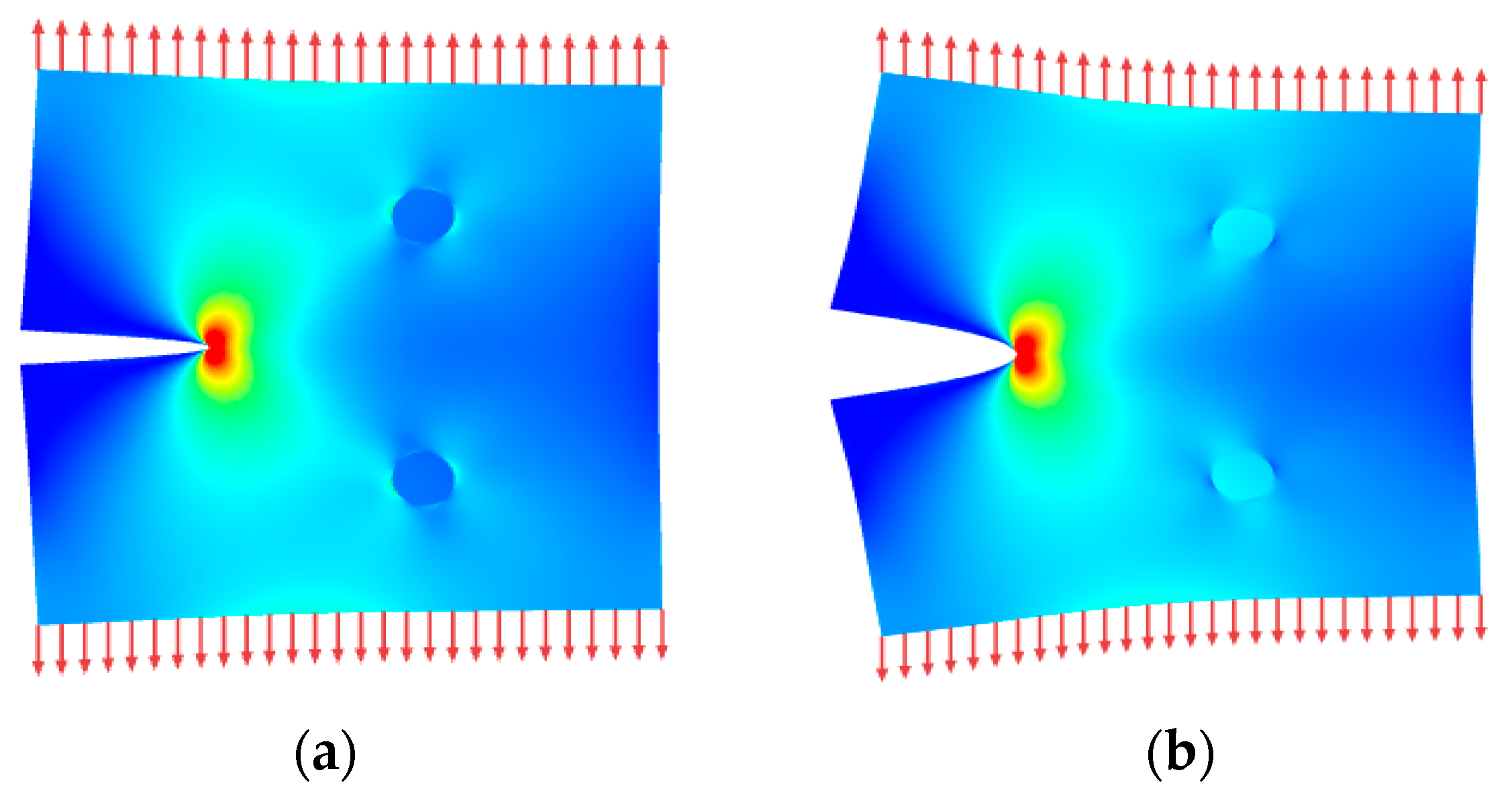Modeling Fracture Properties for Heterogeneous Materials Using J-Integral †
Abstract
:1. Introduction
2. Materials and Method
2.1. Energy Release Rate
2.2. Propagation of a Crack
3. Results and Discussion
Problem of Cracked Square Structure Problem Contains Two Tensile Inclusions
- A circle around the tip of the crack with a radius corresponding to half the length of the crack.
- A circle around the tip of the crack with a radius equal to 0.7 times the length of the crack.
- The outer limits, excluding the surface of the crack.
4. Conclusions
Author Contributions
Funding
Institutional Review Board Statement
Informed Consent Statement
Data Availability Statement
Conflicts of Interest
References
- Griffith, A.A. The phenomena of rupture and flow in solids. Philos. Trans. R. Soc. Lond. 1920, 221, 163–198. [Google Scholar]
- Irwin, G.R. Analysis of stresses and strains near the end of a crack traversing a plate. J. Appl. Mech. 1957, 24, 361–364. [Google Scholar] [CrossRef]
- Rice, J.R. A Path Independent Integral and the Approximate Analysis of Strain Concentration by Notches and Cracks. J. Appl. Mech. 1968, 35, 379–386. [Google Scholar] [CrossRef]
- Elguedj, T. Simulation Numérique de la Propagation de Fissure en Fatigue par la Méthode des Éléments Finis Étendus: Prise en Compte de la Plasticité et du Contact-Frottement. Ph.D. Thesis, INSA de Lyon, Villeurbanne, France, 2006. [Google Scholar]
- Pierre-Olivier, B. Contribution to Numerical Modeling in Fracture Mechanics and Multi-Material Structures. Ph.D. Thesis, Ecole Nationale Superieur des mines de Paris, Paris, France, 2000. [Google Scholar]
- Alan, T.; Zehnder, P. Reading Notes on Fracture Mechanics; Department of Theoretical and Applied Mechanics, Cornell University: Ithaca, NY, USA, 2009. [Google Scholar]




Disclaimer/Publisher’s Note: The statements, opinions and data contained in all publications are solely those of the individual author(s) and contributor(s) and not of MDPI and/or the editor(s). MDPI and/or the editor(s) disclaim responsibility for any injury to people or property resulting from any ideas, methods, instructions or products referred to in the content. |
© 2023 by the authors. Licensee MDPI, Basel, Switzerland. This article is an open access article distributed under the terms and conditions of the Creative Commons Attribution (CC BY) license (https://creativecommons.org/licenses/by/4.0/).
Share and Cite
Boudouh, M.; Hachi, B.E.K.; Taibi, H.; Haboussi, M.; Raga, M.F.; Hachi, D. Modeling Fracture Properties for Heterogeneous Materials Using J-Integral. Eng. Proc. 2023, 56, 277. https://doi.org/10.3390/ASEC2023-15814
Boudouh M, Hachi BEK, Taibi H, Haboussi M, Raga MF, Hachi D. Modeling Fracture Properties for Heterogeneous Materials Using J-Integral. Engineering Proceedings. 2023; 56(1):277. https://doi.org/10.3390/ASEC2023-15814
Chicago/Turabian StyleBoudouh, Mehdi, Brahim El Khalil Hachi, Hadi Taibi, Mohamed Haboussi, María Fernández Raga, and Dahmane Hachi. 2023. "Modeling Fracture Properties for Heterogeneous Materials Using J-Integral" Engineering Proceedings 56, no. 1: 277. https://doi.org/10.3390/ASEC2023-15814





